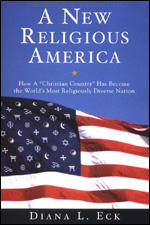 (Reprinted with permission from America, written by Francis X. Clooney.)
(Reprinted with permission from America, written by Francis X. Clooney.)
Eastern Approaches
The Sri Lakshmi Temple is a popular center for the worship of the goddess Lakshmi, known for her graciousness and generosity. Tamil-speaking Hindu priests perform the daily and festival rituals while Hindus young and old come from neighboring towns to beg her favor and celebrate her glory. To Lakshmi’s left is her spouse Vishnu, lord of the universe; to her right, the popular elephant-headed god Ganesh; around the temple’s central space stand Shiva, the mysterious and gracious destroyer of illusions; the loving and playful Murugan; the welcoming Ayappan, who is child of both Vishnu and Shiva; and the beloved monkey god Hanuman. Downstairs there are regular lectures, concerts, and weddings.
But what is probably most striking about this temple is that it is located about thirty miles west of Boston, just past Shoppers World and the Natick Mall, right on the path of the Boston Marathon. Explanations, schedules, and directions are all available on the Web. Dedicated in the early 1990s, the temple has flourished as the premier Hindu worship site in New England. Although most visitors are Hindus of Indian background, almost every time I’ve been there with my students we have seen people not of Indian origin and probably not Hindu by birth.
In fact, though, it is no longer extraordinary to find a Hindu temple in a New England town—or a Sikhgurdwara (temple), a mosque, or a Tibetan, Burmese, or Zen meditation center. Although people of other faith traditions have been coming to America since the nineteenth century and even before, changes in immigration laws in the 1960s made it possible for people of more diverse cultures and backgrounds to immigrate in larger numbers. Religious diversity is here; it is American; it is us.
Probably no one is more attentive to this diversity or better positioned to interpret it than Harvard University’s Diana Eck. A scholar of India’s Hindu traditions, for more than a decade she has been exploring and mapping American diversity and articulating what it tells us about ourselves. The fruits of her Pluralism Project include a 1997 CD-ROM “Common Ground”—and now the book A New Religious America: How a “Christian Country” Has Become the World’s Most Religiously Diverse Nation. This vivid, enormously informative, and necessary volume describes this new diversity in detail, with innumerable anecdotes and personal experiences that bring pluralism to life. Key chapters summarize what Eck has found regarding Hinduism, Buddhism, and Islam, and to a lesser extent other traditions. (Judaism and Christianity, though frequently mentioned, are not the object of study here.)
Honest to her data, Eck also faces the political tensions, stereotypes, and violence against individuals and places of worship, the anxieties of settled communities when newcomers are suddenly neighbors. Indeed, much of the volume is about the “rest of us” who are not newcomers, who are Jewish or Christian (Eck is Methodist) or secularized. It reminds, invites, and challenges us to learn about and with our new religious brothers and sisters—rediscovering ourselves in the process. Fear of the “other” is increasingly nothing but fear of ourselves, for it is “we,” not “they,” who are religiously diverse. To think otherwise cuts us off from the great religious festival of America today. The great task of the twenty-first century is to “create a positive multireligious society out of the fabric of a democracy, without the chauvinism and religious triumphalism that have marred human history.”
We may delight in the idea of “the world’s most religiously diverse nation,” but Eck’s wonderful book still leaves us wondering what exactly God is trying to say to us today.
Appetizer
It began with the “new immigration,” spurred by the 1965 Immigration and Naturalization Act, as people from all over the world came to America and have become citizens. With them have come the religious traditions of the world—Islamic, Hindu, Buddhist, Jain, Sikh, Zoroastrian, African and Afro-Caribbean. [They] . . . moved into American neighborhoods, tentatively at first, their altars and prayer rooms in storefronts and office buildings, basements and garages, recreation rooms, and coat closets, nearly invisible to the rest of us. But in the past decade, we have begun to see their visible presence.
—A New Religious America